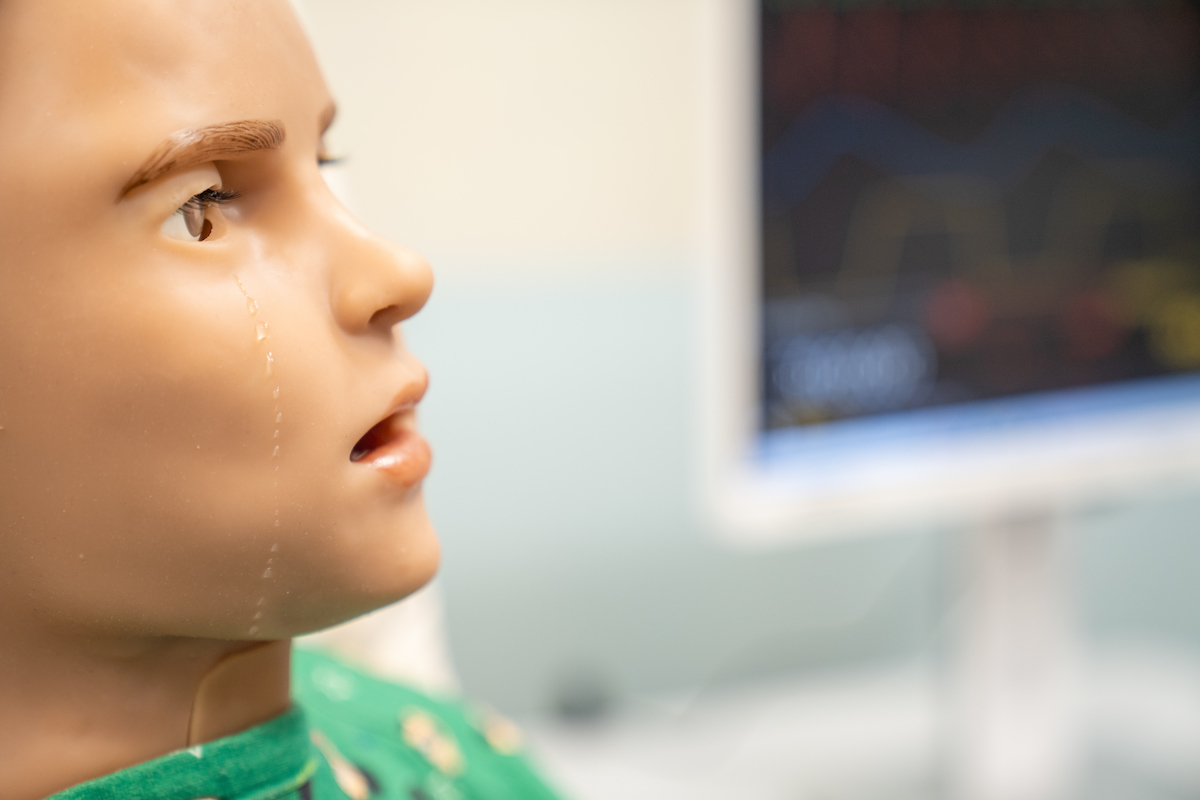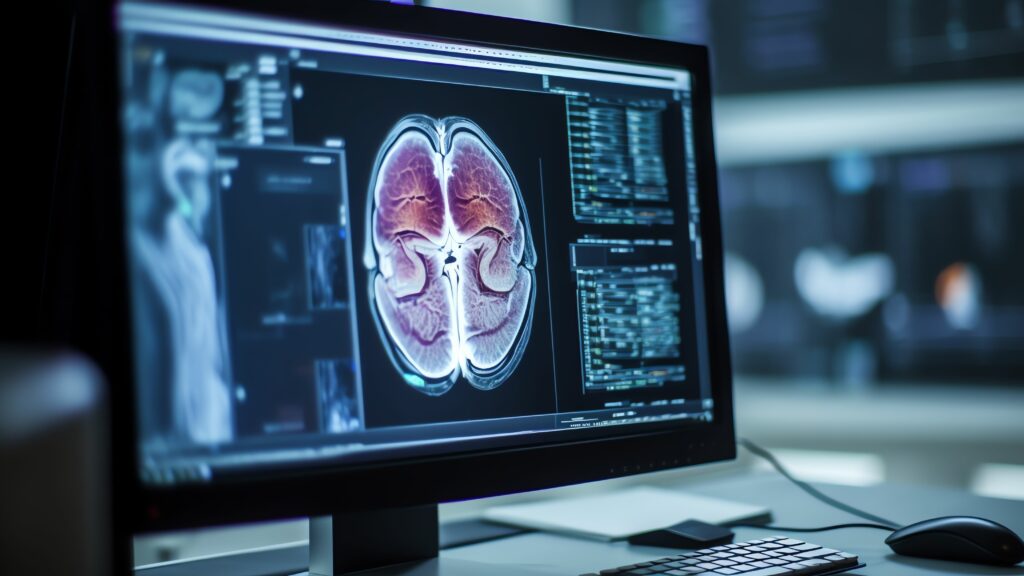
High Fidelity Simulation creates a hands-on activity environment with realistic training manikins that are as lifelike as it can get. Medical students no longer rely just on books and PowerPoints to supplement what’s needed to learn and practice in the real world. High Fidelity Simulation allows students from their pre-clinical years to clinical years and beyond to step into practice in a simulated environment before going out and practicing the real thing.
“There is low vs high fidelity simulation. If you were to blind fold a physician and ask them to feel inside a low and a high-fidelity manikin this is what they would feel. A low fidelity manikin feels more plastic and artificial. It does not feel real. The texture and the tissue feel different from a human body. If you feel a high-fidelity manikin, this feels real. The organs are where they are supposed to be, and the artery pulsations feel real,” said COMP Medical Director of Simulation Joachim Brown, DO.
High Fidelity Medical Simulation is a newer edition to medical schools and educators to enhance medical students’ overall education. Medical simulation is built around high-fidelity manikins incorporating procedures and case scenarios into the student’s curriculum.
This allows students hands on experience in taking history, feeling normal and abnormal physical examination findings, incorporating diagnostics into cases, and coming up with an overall assessment and plan. It allows educators the opportunity to change the parameters of patient cases from a stable to an unstable environment that is experienced in hospital settings.
“This is different than other educations learning model “see one, do one.” Learners see a procedure and then do one on a real patient. Once comfortable then they teach one. The new learning model is, “practice one, see one, do one, and teach one.” This model builds confidence for both the student and patient and removes complications on patients,” Brown said.
COMP and COMP-Northwest updated and expanded their simulation spaces and equipment to provide students with the highest-quality medical simulation experiences.
The Sarkaria Family Patient Simulation Suite on the WesternU California campus is an innovative learning space with state-of-the-art equipment, funded by a generous donation from the Sarkaria family.
The Medical Simulation Suite includes a surgery/operating room (OR/ER), labor/delivery (OB/GYN) room, four simulation flex rooms for novel technologies and other simulation technologies that can adapt to the needs of the students, faculty, and staff, two Med-Sim Control Rooms, and one Digital Immersive Training Environment room. The simulation suite has four patient simulators, or manikins: HAL, Pediatric HAL, VICTORIA and baby Tory.
Take a tour
The Simulated Medicine and Readiness Training (SMaRT) Lab on the WesternU Oregon campus consists of three hospital rooms – surgery/operating room, labor/delivery room and three-bed emergency department – as well as a skills training area for students featuring high-end patient simulators. The SMaRT Lab training equipment is funded by a generous donation from the Heatherington Foundation for Innovation and Education in Health Care. The SMaRT Lab has: The SimMan 3G PLUS, The VICTORIA S2200, and Pediatric Hal S2225.
Take a tour
Medical simulation is the new paradigm; everyone has a need, and the need is abundant. A first-year student is going to think they need to perform a central line, but it’s not necessary for every student to learn it at this early stage in their education. First years need to watch and observe, while second years apply their skills and perform it. The first step is to categorize the need and the second step is satisfying those needs with where they belong and what is needed to fulfill them.
Procedures on task trainers and manikins are a big component of medical simulation. Procedures build confidence and reduces the errors and bad outcomes in some situations.
Students perform a lot of procedures, for example central line, paracentesis, thoracentesis, ACL’s type activities, cardio, OBGYN, pediatric and neonatal cases. Learning at the bedside, we create that type of environment. The use of high-fidelity simulators allows the opportunity to create classic cases and incorporate learning objectives to those. This is how they learn in clinical years.
How students learn:
- Performing a central line: Learners use a SIM torso to place a large needle that’s inserted into a vein within the neck to gain access.
- The High-Fidelity Surgical Simulator: This simulator has organs and blood vessels in all the right anatomic structure, which allows for procedures to be done as they would be on a real patient regarding non-surgical patients.
- High Fidelity Manikins: These manikins have built-in artificial intelligence to respond to a student. It provides normal and abnormal sounds, physical examination findings and much more as you would find on a patient with a specific diagnosis. The simulator can be programmed to give a diagnostic for a specific case. Students practice medical techniques on high-fidelity patient simulators that can be programmed to mimic stroke, seizure, childbirth, and many other clinical presentations and responses.
During case scenarios, educators set objectives for the students going through each organ system. For example, the labor delivery process. The objective needed to be met is performing a normal delivery. Skills and complexity are increased as the student progresses through medical school. For third and fourth–year students, a normal delivery turns into a complicated scenario and students will gain experience in more complicated scenarios, for example, a shoulder dystocia or hemorrhaging.
“The beauty of simulation is it allows us to have a teachable moment. We can stop in the middle of a procedure and explain what the student should have done. You can do real-time correction without harming the patient,” said COMP Associate Professor of Surgery and Anatomy Marian Safaoui, MD.
Simulation allows both individual and team performance, which allows two different styles of learning. In the world of medicine, an individual task would be placing a central line. A team-based approach is running a code blue involving several team members assigned with different roles. The outcomes are the same for both, students need to be organized, assertive and know the next steps to take.
The key advantages of Medical Simulation are preparedness and being able to mitigate any fear and anxiety. We can prepare them for the real world without being in the real world. This is measured with medical professionals performing in post grad years and the direct reflection on how well they were prepared. Second is mitigating fear and anxiety between the transition from pre-clinical to clinical years and the transition from fourth year to residency. These transitions cause a lot of anxiety in students, but the key advantage is to help mitigate that anxiety when jumping into residency years. It’s underestimated, the jump has on our student’s mental wellbeing.
“Sim labs are the most effective way to train somebody how to do medicine because it reinforces the learning you get in the classroom, decreases anxiety, and prolongs retention of that knowledge. It keeps students motivated to work. It motivates them to go back in and study harder for exams,” said COMP-Northwest Medical Director of Simulation Derrick Sorweide, DO.
Identifying performance gaps is very important. Simulation technology allows gaps to be addressed allowing students to do it and correct it. Computer programs show students’ progress with data displaying how students are learning and the rate they are learning. “Filling those gaps are easy within high fidelity simulation. If the learner did not compress deep enough, it’s a matter of whether of can they compress deep enough,” Brown said.
Most students don’t know what specialty they want to go into. Simulation offers students the exposure of different activities within specific specialties that allows students to make their specialty decision much earlier.
When it comes to improving the quality of learning, quality is equal to clinical context. The overall effect of high-fidelity simulation is measured through the learner’s confidence. Students transition from pre-clinical to clinical years within medical education with a fear of not feeling prepared enough for rotations. Medical Simulation closes the gap on preparedness without the feeling and fear of not having enough hands-on activities.
“Students can practice in the skills lab as much as they want. Repetition and familiarity decrease anxiety and increase skill development,” Sorweide said. “Those lessons then shine in the real-world environment. Most people wouldn’t want to fly with a pilot who did not practice on a simulator. The same is true for medical care.”


